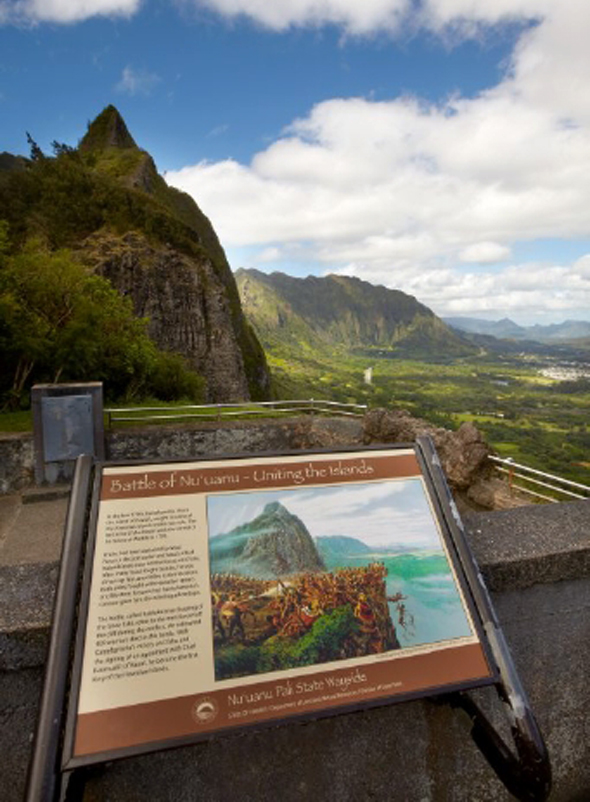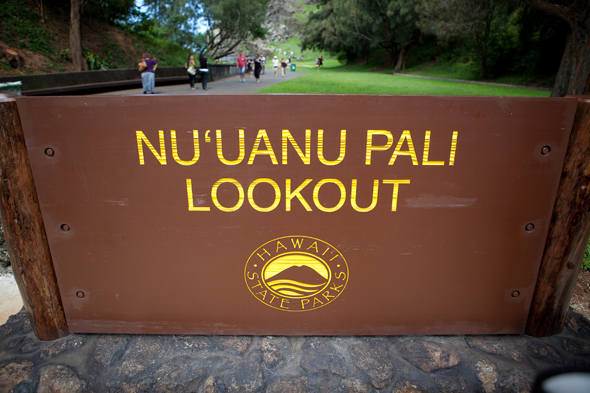A POSTCARD-WORTHY LOOKOUT

If you find yourself winding your way through Nu`uanu Valley you’ll want to make a pit stop at the Pali Lookout, a must see state park in Hawai`i. Located at the top of the Pali Highway and nestled between Windward Oahu and downtown Honolulu, this popular visitor destination is tucked amidst lazy clouds and weeping waterfalls.
With a view that will sweep you away, the Pali Lookout is located more than a thousand feet above sea level, serving up breathtaking sights of the verdant Ko`olau Mountains and picturesque Windward coast. On a clear day, visitors can spot Mokoli`i (little lizard) island off in the distance. Pack an extra jacket but plan to leave your hat (and loose accessories) in the car while posing for photos as you lean into Hawai`i’s balmy, sweet wind. At the lookout wind gusts have been known to reach up to 50 miles per hour.
Open during daylight hours, the lookout is perfect for families, nature lovers and those on a tight budget (there is only a $3 charge for parking). Better yet, if you can drag along a friendly kama`aina (local) parking is free!

The Battle of Nu`uanu
In Hawaiian “pali” translates to “cliff” and this island ridge offers more than just a pretty view. The Pali Lookout also has a dark side, playing a role as the site of the historical 1795 Battle of Nu`uanu. Also known as Kalelekaanae — or “the leaping mullet” referring to the Oahu warriors who were driven off the cliff — the battle helped cement King Kamehameha I’s union of the Hawaiian Islands.
Known as Kamehameha the Great, Kamehameha I’s mission to unite the islands started in 1783. Supplied with modern weapons including muskets and cannons, and training from a British sailor, John Young, he was able to defeat rival chiefs on Hawaii Island.
In February 1795, Kamehameha made landfall on Maui with what historians estimate as between 10,000 to 12,000 soldiers and more than 1,000 war canoes. Unable to defend her people, Queen Kalola married her granddaughter, Keopuolani, to Kamehameha bringing the islands of Maui and Molokai with her under his rule.
When Kamehameha waged war on Kalanikupule’s army on Oahu the two met at Punchbowl crater (the current site of the National Memorial Cemetery of the Pacific). Injured by cannon fire, Kalanikupule and his men retreated into Nu`uanu where they were forced to retreat to the top of the Pali. Here, hundreds of warriors plummeted 1,000 feet to their deaths.
Kamehameha formally established the Kingdom of Hawai`i in 1810 when King Kaumuali`i who ruled over the remaining islands of Kauai and Niihau agreed to submit to Kamehameha’s rule.

Nu`uanu No Ka Oi
Since ancient Hawai`i the Nu`uanu Pali area has been a vital area for travel as one of the low and easily passable sections of the Ko`olau mountain range that connects Honolulu to Oahu’s Windward side.
The first road was built over the Nu`uanu Pali in 1845. In 1898 as this road was being developed 800 skulls were discovered, which many believe to be the remains of the warriors who fell from the cliff above. This road was later replaced by the Pali Highway and Pali Tunnels in 1959.
The Pali area is also home to the Nu`uanu Freshwater Fish Refuge and Nu`uanu Reservoir, one of four reservoirs in Nu`uanu located along the Pali Highway. The four reservoirs were built between 1890 and 1910 for the purposes of hydropower, flood controls and domestic water. Shortly after World Ward II, the territorial government introduced freshwater game fishes and the Nu`uanu Reservoirs were used as a refuge and research site for sport fish. The first opening for catfish fishing took place July 5-6, 1969, during which 96 anglers were able to land 339 catfish.
A Pali Possessed
Of the many superstitions and obake (ghost) stories of areas throughout Hawai`i the Nu`uanu Pali has its fair share – including tales of a mo`o wahine (lizard woman) who leads male travelers to their deaths over the Nu`uanu cliffs and hungry spirits who attack visitors for their food.
One of the better-known stories caution travelers against carrying pork over the Pali Highway. Hawaiian folklore says that Pele (a powerful Hawaiian goddess, known for being the deity of fire, lightning, wind and volcanoes) prevents passage over the area because of her contest with Kamapua`a, a half human, half hog god. Some motorists have mysteriously reported their cars stopping – especially at night – and being unable to restart their vehicle until the pork was removed.
